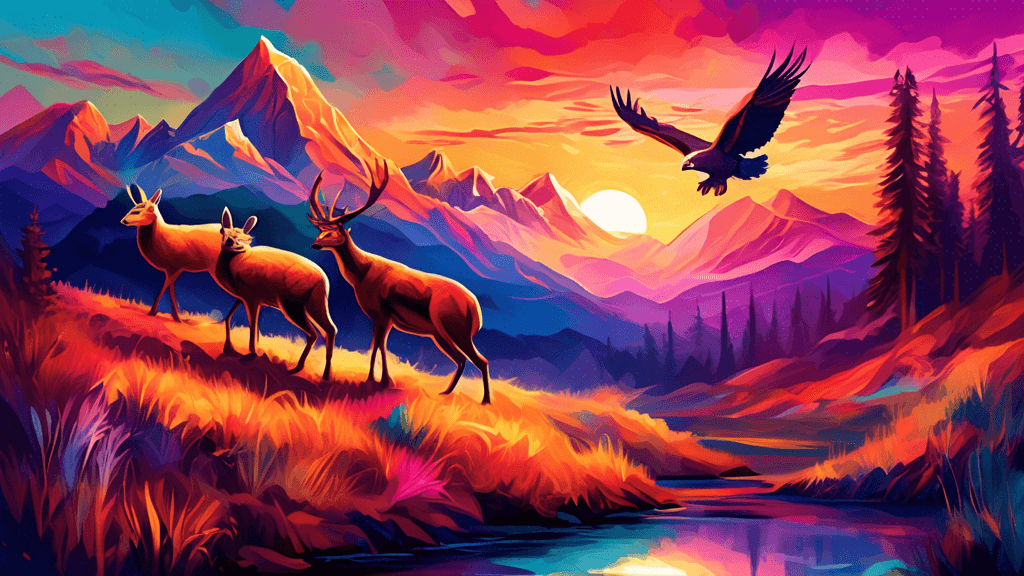
Nature's Masterpiece: Integrating Wildlife into Scenic Vistas
Share
Have you ever stumbled across a scene in nature so stunning that it almost felt like a painting? Imagine a crimson sunset cascading over a serene lake, a majestic eagle soaring high above, completing the picturesque scene. This perfect blend of landscape and wildlife not only captivates the heart but also stimulates a deep appreciation for the natural world. But why does this integration of wildlife into scenic vistas matter so much, and how does it affect both our perception of art and nature conservancy?
The Artistic Value of Wildlife in Landscapes
Integrating wildlife into scenic landscapes elevates a photograph or a painting from merely beautiful to profoundly impactful. It is the unpredictability and the grace of wildlife that adds a vital pulse to the tranquility of landscapes. Renowned nature photographer Ansel Adams, known for his black-and-white landscape photographs of the American West, once said, There are always two people in every picture: the photographer and the viewer. The presence of wildlife invites the viewer to look deeper into the image, creating a dynamic interplay between the viewer's imagination and the real-world charm of the vista.
Educational and Conservational Impact
Beyond aesthetics, featuring wildlife in natural landscapes has significant educational and conservational value:
- Awareness: Capturing wildlife within their habitats highlights the beauty and the fragility of these ecosystems. It serves as a compelling visual plea for the conservation of endangered habitats.
- Behavioral Insight: Observing animals in their natural setting can provide invaluable insights into their behaviors and natural cycles, aiding scientific research and educational initiatives.
- Ecological Importance: Each element in a photograph—from the smallest insect to the towering trees—plays a crucial role in its ecosystem. Showcasing this interdependence can help illustrate the importance of biodiversity.
Challenges in Capturing Wildlife
However, as any wildlife photographer will tell you, integrating animals into landscape photography is no small feat. Wildlife photographers often face numerous challenges:
- Timing and Patience: Wildlife does not operate on a schedule. Capturing the perfect moment where the natural behavior of animals aligns with the right lighting and composition requires patience and a bit of luck.
- Technical Skill: Balancing the technical aspects of landscape photography with the unpredictable movement of wildlife demands a high level of skill and experience.
- Ethical Considerations: Ensuring that the presence of the photographer does not disturb the natural behavior of the animals is paramount. Recent guidelines emphasize the importance of minimizing impact and respecting wildlife.
Learning From the Masters
What can aspiring photographers and conservationists learn from the masters of this craft? Profound lessons emerge from the work of individuals like Frans Lanting, a Dutch photographer known for his ability to blend landscapes with wildlife photography seamlessly. Lanting suggests that the key to successful wildlife landscape photography lies in understanding the environment and anticipating animal behavior. This level of empathy and understanding can take years to develop but is crucial for capturing nature in its truest form.
To enhance your own skills, consider these steps:
- Research: Detailed knowledge of the natural history and behavior of the species involved can significantly improve the chances of a successful shoot.
- Practice: Regular visits to wildlife-rich landscapes can increase familiarity with the area and its animal movements and timings.
- Conservation First: Always prioritize the well-being of the environment and its inhabitants over getting the perfect shot.
Conclusion: A Call to Action
Integrating wildlife into scenic vistas is not just about capturing breathtaking images; it's about storytelling and advocating for the uninterrupted preservation of nature's marvels. As we continue to face global environmental challenges, the role of visual storytellers becomes ever more critical. They not only bring the beauty of the natural world to the public's eye but also play a pivotal role in its preservation.
So, whether you are a photographer, an artist, or simply someone who enjoys the splendor of nature, take a moment to appreciate these complex and vital scenes. Better yet, pick up a camera or a brush, and contribute to the ongoing narrative of our planet's extraordinary biodiversity. Remember, every image you share can help raise awareness and inspire more people to join the cause of conservation. What will be your impact?





